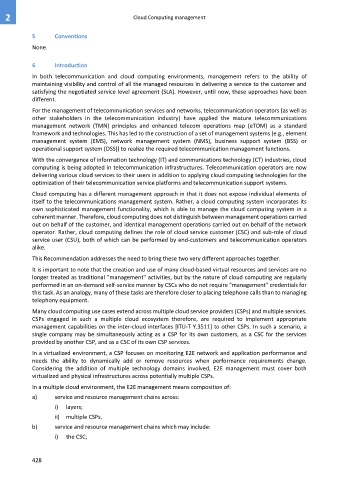Page 436 - Cloud computing: From paradigm to operation
P. 436
2 Cloud Computing management
5 Conventions
None.
6 Introduction
In both telecommunication and cloud computing environments, management refers to the ability of
maintaining visibility and control of all the managed resources in delivering a service to the customer and
satisfying the negotiated service level agreement (SLA). However, until now, these approaches have been
different.
For the management of telecommunication services and networks, telecommunication operators (as well as
other stakeholders in the telecommunication industry) have applied the mature telecommunications
management network (TMN) principles and enhanced telecom operations map (eTOM) as a standard
framework and technologies. This has led to the construction of a set of management systems (e.g., element
management system (EMS), network management system (NMS), business support system (BSS) or
operational support system (OSS)) to realize the required telecommunication management functions.
With the convergence of information technology (IT) and communications technology (CT) industries, cloud
computing is being adopted in telecommunication infrastructures. Telecommunication operators are now
delivering various cloud services to their users in addition to applying cloud computing technologies for the
optimization of their telecommunication service platforms and telecommunication support systems.
Cloud computing has a different management approach in that it does not expose individual elements of
itself to the telecommunications management system. Rather, a cloud computing system incorporates its
own sophisticated management functionality, which is able to manage the cloud computing system in a
coherent manner. Therefore, cloud computing does not distinguish between management operations carried
out on behalf of the customer, and identical management operations carried out on behalf of the network
operator. Rather, cloud computing defines the role of cloud service customer (CSC) and sub-role of cloud
service user (CSU), both of which can be performed by end-customers and telecommunication operators
alike.
This Recommendation addresses the need to bring these two very different approaches together.
It is important to note that the creation and use of many cloud-based virtual resources and services are no
longer treated as traditional "management" activities, but by the nature of cloud computing are regularly
performed in an on-demand self-service manner by CSCs who do not require "management" credentials for
this task. As an analogy, many of these tasks are therefore closer to placing telephone calls than to managing
telephony equipment.
Many cloud computing use cases extend across multiple cloud service providers (CSPs) and multiple services.
CSPs engaged in such a multiple cloud ecosystem therefore, are required to implement appropriate
management capabilities on the inter-cloud interfaces [ITU-T Y.3511] to other CSPs. In such a scenario, a
single company may be simultaneously acting as a CSP for its own customers, as a CSC for the services
provided by another CSP, and as a CSC of its own CSP services.
In a virtualized environment, a CSP focuses on monitoring E2E network and application performance and
needs the ability to dynamically add or remove resources when performance requirements change.
Considering the addition of multiple technology domains involved, E2E management must cover both
virtualized and physical infrastructures across potentially multiple CSPs.
In a multiple cloud environment, the E2E management means composition of:
a) service and resource management chains across:
i) layers;
ii) multiple CSPs.
b) service and resource management chains which may include:
i) the CSC;
428

